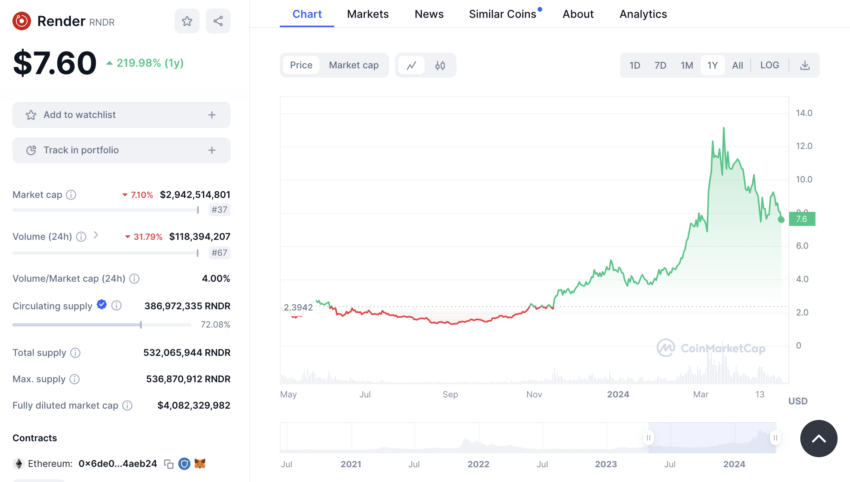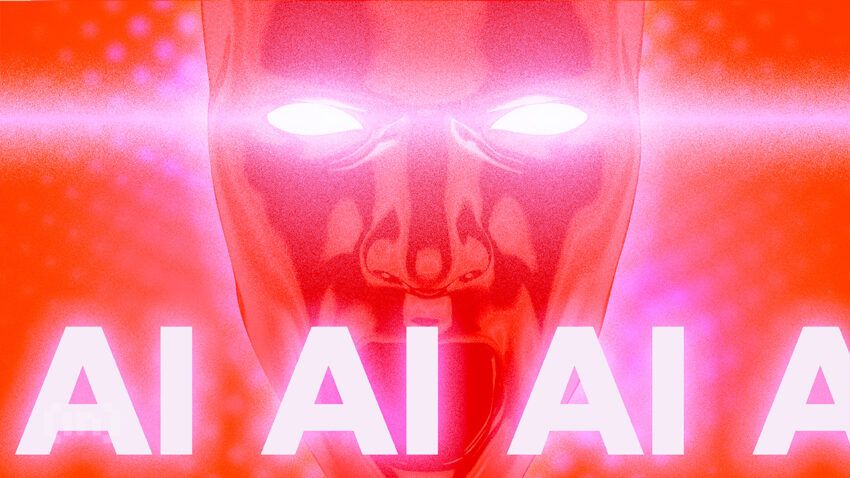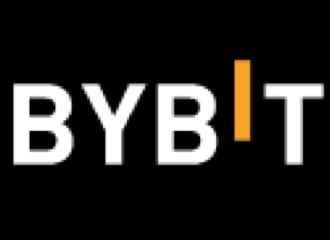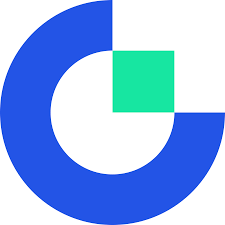Render Network’s native token RENDER (previously RNDR) has weathered the crypto market’s volatility while experiencing steady growth year-on-year. This raises the question: what’s driving this long-term surge? Is RENDER a good long-term investment? We will explore these questions and more in this Render token guide.
KEY TAKEAWAYS
• Render is a decentralized GPU rendering network for powering 3D, AR, and VR projects.
• It utilizes unused GPU power of network participants to offer cost-effective and efficient rendering services.
• RENDER is the native utility token of the Render Network.
• The Render ecosystem has use cases in film, gaming, AI projects, product design, architecture, and more.
- What is Render token (RENDER)?
- The team behind Render Network
- Render Network: Under the hood
- What makes the Render Network unique?
- What is RENDER’s role?
- RNDR to RENDER transition
- Where to buy RENDER?
- 1. OKX
- 2. Coinbase
- 3. Bybit
- 4. Gate.io
- A quick guide on Render Network’s use cases
- Is Render token a good investment in 2024?
- Frequently asked questions
What is Render token (RENDER)?

Render is a platform that enables users to lend the unused GPU capacity of their home devices to support projects in rendering motion graphics and visual effects.
In return, contributors receive Render tokens (RENDER), the native utility crypto of the Render Network. Launched in 2020, the token reached over 30,000% above its initial price by March 2024. As of August 23, 2024, despite the ongoing market slowdown, RENDER is still up by more than 13,300%.
Render Network allows individuals to access underutilized computational resources affordably and efficiently by establishing a peer-to-peer (P2P) network. This approach streamlines the traditional methods of rendering and streaming 3D environments and other visual effects.
“The main reason why Render token has exploded is because of its AI and GPU/ Nvidia’s narratives. The partnership with Apple also gives credibility and opens up a huge market opportunity for RENEDR to showcase its technological edge over competitors.”
— Anndy Lian, blockchain expert: CMC
Did you know: RNDR was originally the native asset in the Render Network. However, the network has since migrated from RNDR to RENDER. We’ll explore the details of this transition later in the piece.
Addressing the computational resources: A growing concern
Next-generation media production presents a significant challenge due to the substantial computing power it demands. Although powerful, today’s centralized GPU clouds must meet these growing requirements.
Consequently, artists and creators frequently face a competitive scramble for GPU resources. These resources are crucial for traditional rendering cloud streaming and training AI models. This competition leads to a need for more available computing power and drives up costs, which inevitable makes it expensive for many artists.
The need for more powerful rendering will grow as technology advances, especially with augmented and mixed-reality content. This demand intensifies existing shortages in computing resources.
The crypto mining industry consumes vast GPU resources, yielding diminishing returns as rising energy costs outpace mining profits. This issue has grown more pronounced with the adoption of more energy-efficient blockchain technologies like proof-of-stake.
Render Network’s solution
Render Network proposes a potentially transformative solution in response to these challenges. It capitalizes on the underutilized GPU cycles by creating a decentralized network that connects content creators with GPU providers.
The network enables creators needing additional computational power to access others’ idle GPU resources to render tasks. The Render Network simplifies the complex process of rendering and streaming detailed virtual creations.
It alleviates the load on individual GPUs and reduces the overall demand on centralized resources by distributing GPU-based rendering jobs across a peer-to-peer network.
This system makes rendering processes quicker and less costly for creators and allows GPU owners to monetize idle capacities.
Render Network’s reach extends far beyond just rendering solutions. It offers a platform for various applications, from crowdsourcing 3D projects to managing digital rights.
This creates an exciting new marketplace where digital ideas, assets, and applications can be funded and leveraged by anyone — from individual developers and artists to large studios. This, in turn, encourages innovation and collaboration among stakeholders.
The team behind Render Network

Render Network was founded in 2017 by Jules Urbach, the CEO of OTOY Inc. OTOY specializes in content creation and rendering software and technology, such as the OctaneRender.
Urbach’s vision for the Render Network stemmed from his experiences and challenges within the graphics industry around the high costs and technological barriers that small creators face when accessing advanced rendering capabilities.
Render Network is based in the Cayman Islands and is led by Kalin Stoyanchev, Head of Blockchain; Charlie Wallace, Chief Technology Officer; and Phillip Gara, Director of Strategy.
Render Network: Under the hood
The Render Network architecture includes a dual-layered system designed to streamline the rendering process using decentralized computing power. Here’s a quick look at its main components:
The off-chain rendering network
The first layer of the Render Network architecture is the off-chain rendering network. This layer primarily consists of:
- Creators: Individuals or entities that generate digital content and require rendering services. They initiate rendering tasks by submitting them to the network.
- Node operators: These operators run GPU nodes, which are essential for providing the computational power needed to perform rendering tasks. You could think of these nodes as the muscle of the network as they execute the heavy-lifting processes required to render complex digital content.
- Render Network and application layer vendors: This component acts as the mediator and framework within which the Node Operators and Creators operate. It includes the software, protocols, and standards for rendering tasks.
A core network infrastructure comprising multiple servers facilitates the interaction between Creators and Node Operators. This setup ensures the efficient management of data exchange and task allocation across the network. This, in turn, helps maintain a smooth operational flow without central oversight.
Blockchain layers

The second layer of the Render Network architecture revolves around blockchain technology, which handles financial transactions and ensures transparency:
- Payment system through RENDER and escrow contracts: These tokens facilitate transactions from Creators to Node Operators. The platform deploys escrow contracts to secure the tokens while a rendering job is underway. This is to ensure that the recipients receive their payments only upon the successful completion of tasks.
- Public ledgers for transparency: Using a blockchain’s public ledger is crucial in Render Network’s modus operandi. It records all interactions between Creators and Node Operators, which ensures that each transaction and its outcomes are transparent and publicly verifiable. This transparency is vital for trust, and allows any transaction discrepancies to be easily tracked and rectified.
OctaneBench and Multi-Tier Pricing (MTP) algorithm
A key component in the Render Network’s operational model is the integration of OctaneBench. This tool benchmarks a GPU’s rendering performance using a metric called OctaneBench Points per Hour (OBh). This measurement is critical because it directly influences the cost of rendering tasks.
OctaneBench ensures that pricing is fair based on the computational power of standardizing GPU performance.
The platform dynamically calculates the pricing of tasks using a Multi-Tier Pricing (MTP) algorithm. This algorithm adjusts the cost based on the rendering task’s complexity and the GPU’s performance as measured by OctaneBench.
This setup ensures that Creators can anticipate and control their rendering expenses based on predictable performance metrics.
What makes the Render Network unique?
Render Network cuts through the noise with features that empower creators and GPU providers. Here’s what makes it a potential game-changer:
- Decentralized rendering solutions: Render Network shifts from traditional centralized rendering to a decentralized peer-to-peer model, utilizing a global network of GPU providers. This approach democratizes access to high-powered resources and improves efficiency, allowing content creators to enjoy faster processing times without the limitations of traditional setups.
- Adaptive pricing: The dynamic pricing model adjusts to real-time market conditions, rendering complexity and urgency.
- Smart matchmaking: Render Network’s advanced matchmaking algorithm pairs content creators with the most suitable GPU providers based on GPU type, capacity, provider location, and reputation. This targeted approach enhances speed, precision, and cost efficiency in rendering tasks.
- Secure and trustless: Render prioritizes security with a trustless validation mechanism, ensuring rendered products meet quality standards via decentralized consensus.
What is RENDER’s role?
RENDER functions primarily as a utility token, enabling the core operations of the Render Network. It facilitates transactions within the network, where content creators pay for rendering services using RENDER. This method simplifies the exchange process, directly linking the demand for rendering power with the supply provided by GPU operators.
Currently, the network offers different tiers of service — Tier 1 (Trusted Partners), Tier 2 (Priority) and Tier 3 (Economy).
Each tier is designed to cater to various speed, security, and price needs, offering flexibility to content creators depending on their specific project requirements and budget constraints.
RENDER also serves as a reward mechanism for Node Operators, the GPU providers within the network. These operators can utilize their idle GPU resources to fulfill rendering jobs in exchange for RENDER tokens.
Additionally, RENDER also acts as a governance token. It grants holders the power to influence the decision-making processes within the Render Network. This governance role empowers token holders to vote on key proposals that shape the network’s future, including protocol upgrades and policy changes.
RNDR to RENDER transition
In November 2023, the Render Network Foundation decided to upgrade its technical architecture by migrating from Ethereum (ETH) to Solana (SOL). This upgrade involved transitioning from the older $RNDR token (an ERC-20 token on Ethereum) to the new $RENDER token (an SPL token on Solana).
The decision to upgrade to Solana was made following a community vote (RNP-002) ending on Nov. 29, 2023. Solana was chosen for its superior speed, lower transaction costs, and scalability.
$RNDR continues to exist
Although $RNDR continues to exist as of August 2024, future developments and support from the Render Network Foundation will focus on $RENDER. Because of that, the Render Network Foundation recommends that RNDR token holders swap their tokens for RENDER.
The upgrade process allows users to convert $RNDR to $RENDER at a 1:1 ratio. $RNDR tokens are burned during the upgrade as they are swapped for $RENDER. Note that you will require a Solana wallet to store $RENDER.
Initially, the Render Foundation covered gas fees for upgrades performed by January 31, 2024. However, this offer has expired, and users are now responsible for their gas fees.
The upgrade process
The Render Network Upgrade is managed through the official Render Network Upgrade Portal. The Render Foundation partnered with Otter Security to audit the bridge code and ensure a secure upgrade. For additional security, users are advised to remain vigilant and only use official links to avoid scams.
After the upgrade, all Render Network jobs, including 3D rendering and AI tasks, will require payment in $RENDER. The $RNDR credits system will be replaced by a new credits program aligned with the Burn-Mint-Equilibrium model.
The upgrade process is one-way, meaning tokens upgraded to $RENDER cannot revert to $RNDR on Ethereum.
Check out the Render Knowledge Base for more info on the RNDR to RENDER transition.
Is it mandatory to upgrade to $RENDER?
Although $RNDR will still be tradable on centralized exchanges, the Render Foundation will no longer maintain it, and it won’t be usable on the Render Network. Voting and governance will continue with both $RNDR and $RENDER token holders until $RNDR voting is eventually phased out.
Incentives for upgrading tokens are available from October 2023 until October 2024. Refer to the Render Network’s RNP-006 documentation for further insights on incentives.
Render token (RENDER) tokenomics
As of Aug. 22, 2024, RENDER has a total circulating supply of over 532M tokens out of its max. supply of 644,168,762 tokens.
The distribution of these tokens is strategically allocated to support various aspects of the network’s growth and sustainability:
- 40% allocated to development efforts
- 25% dedicated to growth initiatives
- 20% for operational needs
- 10% for network reserve
- 5% for network genesis
This allocation strategy aims to ensure the long-term development and scalability of the Render Network.
Where to buy RENDER?
Before we explore the ins and outs of the Render Network, here’s a quick list of leading compatible platforms where prospective investors can scoop up RENDER in 2024.
1. OKX
We like OKX for its versatility and appeal to beginners and experienced users. It offers a broad selection of trading pairs for RENDER, including fiat options, making it accessible for new investors. The platform ensures smooth transactions with high liquidity and provides a user-friendly interface.
Additionally, OKX prioritizes security with robust measures like cold storage and two-factor authentication, ensuring the safety of your RENDER.
- Automated trading bots
- Low fees
- Wide range of crypto
- Margin and leverage trading
- The interface may be intimidating for new users
2. Coinbase
Coinbase is the ideal starting point for crypto beginners due to its user-friendly interface, which simplifies the purchase of RENDER and other crypto. The platform ensures peace of mind with excellent security features, including insured digital assets and FDIC-insured USD balances.
Coinbase provides a vast pool of educational resources to enhance your understanding of crypto and investment concepts. Additionally, the platform supports diverse payment methods, such as bank transfers and debit cards for facilitating a smooth transaction process.
- Easy-to-use interface for crypto newbies
- Strong security measures and insured USD balances
- Offers a variety of crypto
- Provides educational resources to understand RENDER and various crypto
- Supports various payment methods for buying RENDER
- Fees can be higher compared to other exchanges
- Fewer advanced trading features for experienced users compared to some of the other exchanged we tried
3. Bybit
Bybit lets you trade RENDER directly with major cryptocurrencies like BTC and USDT in a secure and hassle-free setup. The platform’s high liquidity supports smooth order execution, and advanced features such as leveraged trading and derivatives are available for users with more experience.
Additionally, Bybit secures user confidence with its stringent security and a 100% proof of reserves (PoR) policy.
- Spot, margin, and futures contracts cater to diverse trading strategies
- Low trading costs
- Supports multiple fiat currencies
- Unique features like leveraged tokens and IEO participation
- 100% proof-of-reserves ensures verifiable security of your assets
- May have a steep learning curve
- Trading features are more for professional traders
4. Gate.io
Gate.io is another healthy choice for buying RENDER due to its extensive range of digital assets and numerous trading pairs. The platform offers competitively low fees amd referral programs to give users an opportunity to increase their bottom line. Gate.io also provides futures trading and lending services for those looking to explore more sophisticated trading opportunities.
- Low trading fees
- Futures trading and margin opportunities
- Referral programs and lending services unlock additional ways to grow your holdings
- User-friendly interface, mobile app, and multi-language support
- Trade RENDER with a wide selection of cryptos and trading pairs
- Fiat deposit options may be limited
A quick guide on Render Network’s use cases
The Render Network and its RENDER token are revolutionizing the digital content creation by providing decentralized rendering solutions and a utility token system for transactions. Here are some real-life applications of Render Network and the RENDER token:
Film, games, and other media
Render Network offers ample GPU resources that are ideal for creating high-quality graphics in films and games. Notably, artist Raoul Marks utilized the network to render the opening titles of “Westworld Season 4,” showcasing its capacity to support complex artistic projects.
Artificial Intelligence

Render Network has expanded its activities in AI and machine learning. The platform provides computational resources for AI-generated graphics and prototypes, allowing cost-effective rendering of high-quality images for AI applications.
“Generative AI on the inference and training side also fit to the kinds of GPUs that are already on Render. You don’t need an H100 to do training on generative video. One of the more exciting propositions for us is we look at the Apple ecosystem where you have GPUs with 120 gigabytes of video memory, those are out there in the tens of millions.
Jules Urbach: Medium
Tapping into that is going to be a massive win over the cost of the scaling issues we have on centralized clouds. That’s where I see huge advantages of decentralized approaches like we have.”
Architecture and product design
Render Network can come in handy for architects and product designers to produce high-quality 3D visualizations and virtual reality renders. It facilitates large-scale prototyping and detailed design analysis, which can improve design accuracy and presentation.
Paying for jobs
RENDER is the primary currency for transactions within Render Network, where creators pay for GPU power to render graphics. Additionally, the network offers RENDER credits purchasable via bank cards, simplifying the payment process for crypto newbies.
Burn and Mint Equilibrium
The Burn and Mint Equilibrium (BME) model enhances RENDER’s value by adjusting its supply based on network demand. Creators burn RENDER tokens to fund rendering jobs, ensuring ongoing demand. Node Operators earn these tokens as rewards, creating a dynamic economic ecosystem within the network.
Is Render token a good investment in 2024?
RENDER has shown a continued uptrend in its performance over extended periods, including gains year-on-year since its inception. This direction, alongside projections of growth in the rendering industry over the next decade, suggests a bright future for RENDER.
However, like all crypto investments, risks due to market volatility and evolving regulations exist. To make an informed decision, thoroughly researching industry trends, guides, and potential risks is crucial. Understanding the opportunities and challenges can lead to more informed investment decisions.
Frequently asked questions
Determining whether RENDER is a good investment depends on your individual risk tolerance, market conditions, and the overall performance of the cryptocurrency sector. Like all investments, RENDER carries risks, particularly due to the volatility of the crypto market. That said, the RENDER price has shown consistency over the long haul. For instance, it has increased more than 21,000% since launch and more than 350% year-on-year.
Render is a platform that enables users to lend the unused GPU capacity of their home devices to support projects in rendering motion graphics and visual effects. In return, contributors receive Render tokens (RENDER), the native utility token of the Render Network. Render allows individuals to access underutilized computational resources affordably and efficiently by establishing a peer-to-peer (P2P) network.
You can earn RENDER by providing GPU computing power to the Render Network, where users submit rendering jobs that require significant processing power. GPU providers connect their hardware to the network, complete rendering tasks, and receive RENDER tokens as payment. This system allows GPU owners to monetize idle computing resources effectively.
Disclaimer
In line with the Trust Project guidelines, the educational content on this website is offered in good faith and for general information purposes only. BeInCrypto prioritizes providing high-quality information, taking the time to research and create informative content for readers. While partners may reward the company with commissions for placements in articles, these commissions do not influence the unbiased, honest, and helpful content creation process. Any action taken by the reader based on this information is strictly at their own risk. Please note that our Terms and Conditions, Privacy Policy, and Disclaimers have been updated.







